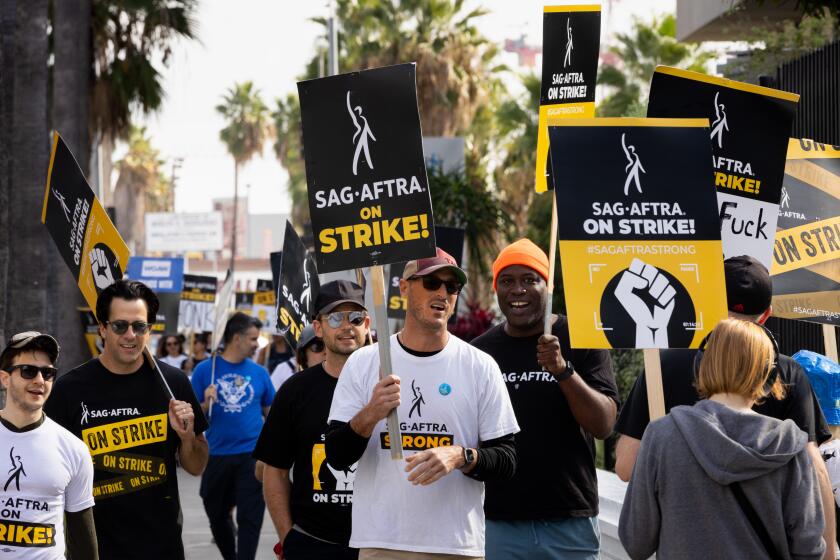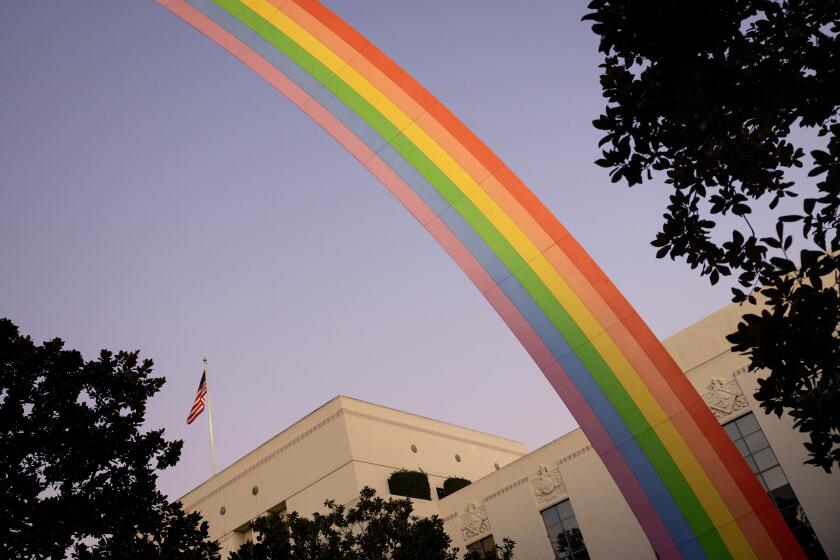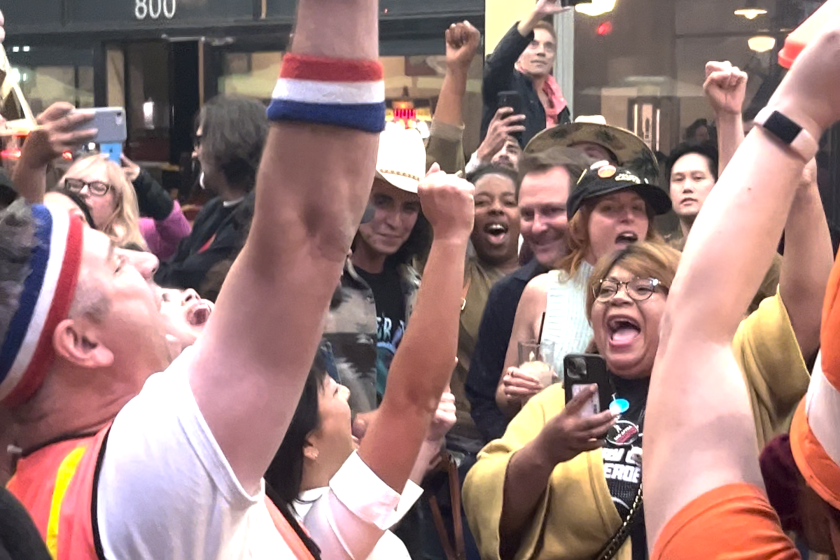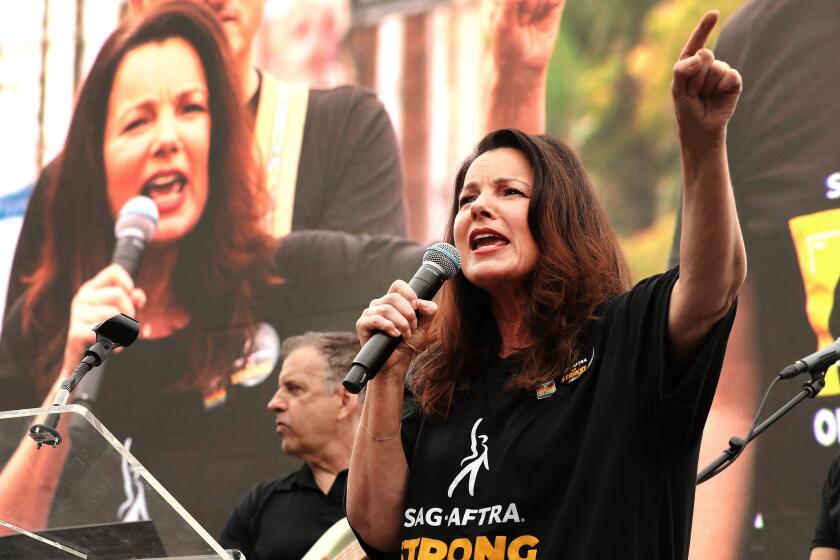A 7% wage increase, new AI protections and other highlights from the SAG-AFTRA contract

- Share via
SAG-AFTRA’s national board of directors on Friday approved a tentative contract negotiated with the major studios earlier this week to end the nearly four-month-long actors’ strike.
The approval, which was expected, clears the way for the contract to be voted on by members. The vote among board members was 86% in favor of the three-year film and TV contract, the union said.
The union ended the strike on Thursday after 118 days, saying it had secured a historic agreement to improve pay and protections for its 160,000 members.
SAG-AFTRA has approved a deal from the studios to end its historic strike. The actors were on strike for more than 100 days.
The tentative contract addresses the core issues that drove actors to the picket lines in July, including higher minimum pay, increased residual payments for streaming shows and improved health benefits, as well as protections related to self-taped auditions and the use of artificial intelligence in filmmaking.
The guild’s negotiating committee said the contract would “enable SAG-AFTRA members from every category to build sustainable careers” and that “thousands of performers now and into the future will benefit from this work.”
After the guild’s negotiating committee reached the deal with the Alliance of Motion Picture and Television Producers, which represents the major studios and streamers, the contract was passed to SAG-AFTRA’s national board. The board reviewed the deal on Friday before voting to approve it.
“This victory is everyone’s victory,” said SAG-AFTRA national executive director and chief negotiator Duncan Crabtree-Ireland, after crediting the union membership’s solidarity throughout the strike. “In this age of artificial intelligence technology, potentially changing the entertainment landscape, protections for performers mean the preservation of tens of thousands of jobs, craft services, costumers, set builders, camera crews, drivers, gaffers … as well as the preservation of countless small businesses that serve the entertainment community.”
The Writers Guild of America ended its strike, which began in early May, last month.
Moody’s Investors Service on Friday estimated the new contracts will cost the studios an additional $600 million a year in costs for production.
SAG-AFTRA’s negotiating committee and the major Hollywood studios have reached a tentative deal to end the 118-day actors’ strike. So what happens now?
“We expect studios will trim their use of A-list talent, greenlight less filming on location and instead use more soundstages and green-screens, and that they will trim postproduction spending and special effects,” wrote Neil Begley, Moody’s senior vice president, in the report.
For the deal to take full effect, the guild still must clear one last hurdle: a vote by guild members to ratify the three-year contract.
The ratification vote by members will begin Tuesday, Crabtree-Ireland said, and will run until the first week of December.
During the announcement of the board’s vote at the SAG-AFTRA headquarters in Los Angeles, Crabtree-Ireland and SAG-AFTRA President Fran Drescher released several of the agreement’s significant gains. A full summary of the deal is expected to be made public on Monday.
Here is a brief breakdown of the contract gains shared during Friday’s announcement:
Higher minimum wages
Overall, the contract won more than $1 billion in new wages and funding for benefit plans.
Guild members can expect a 7% general wage increase effective immediately under the contract. Another 4% increase will go into effect on July 1 of next year, and another 3.5% effective July 1 of 2025. During the first year of the contract, the total wage increase comes out to 11.28%.
“This package breaks the so called industry pattern,” Crabtree-Ireland said.
The deal will also raise the cap on how much members can contribute toward a benefit plan for TV work, which is expected to generate more than $180 million in additional funds to the benefits plans over the term of the contract.
Other gains include increases to allowances given to actors who are required to relocate during the filming of shows. The guild will now offer its members $5,000 per month for up to six months, an apparent 200% increase.
AI protections
On AI, the guild was able to obtain the “informed consent and fair compensation of any “digital replica” for performers. With limited exceptions, the consent by performers “cannot be at the front end, it has to be at use,” Crabtree-Ireland said.
“This contract protects background actors from any digital use without their consent,” Crabtree-Ireland said. “Our background actors are protected in our AI provisions.”
Hollywood’s twin strikes translated into a lost year of production for much of the industry with productions idle since last spring. SAG-AFTRA’s strike against major media companies stretched 118 days.
The contract also addresses the use of “synthetic fake performers” for computer-generated images to replicate performers.
“This is the piece that came together on the very last day,” Crabtree-Ireland said.
The guild will be notified if producers used generative AI to create synthetic performers. The contract allows the industry to go forward, “but allows the performers to be protected.”
Background performers and any use of their likeness are also covered by the same AI informed consent protections.
Streaming bonus
SAG-AFTRA members also fought hard to share the success of streaming shows because the move to streaming has shifted the economics for actors and others who work on shows with shorter episode orders. “We decided together that we needed to go into another pocket of revenue,” Drescher said.
“For 35 days, like a broken record, we said, we need to get into another pocket, we need to get new money from somewhere,” Drescher said. “And every single time we brought it up, the AMPTP said no. In the end, the entertainment companies agreed to provide distributions to SAG-AFTRA for a fund that will pay bonuses to performers — in addition to their typical residuals.”
That fund is expected to generate about $40 million a year, Crabtree-Ireland said, or about $120 million over the life of the three-year contract.
Inside the SAG-AFTRA party to celebrate the end of the Hollywood actors’ strike.
The guild did not detail how the payments from the companies would be calculated. But Crabtree-Ireland said the studio alliance had mandated that at least 75% of the monies to the fund be distributed to the actors who appeared in the successful show. The remaining funds (25%) could be used at SAG-AFTRA’s discretion.
“This is a completely new structure,” Crabtree-Ireland said. “Both on the inbound money side and on the distribution side.”
Many of the details of how the fund will work will need to be worked out over time.
“We’re confident that this will generate an overall number of around $40 million a year, part of which will go to people who work on the shows ... and part of it will go into the fund for a wider distribution,” Crabtree-Ireland said.
Other protections
Another lighting rod for actors amid the strike was self-taped auditions and interviews, which studios began to utilize more frequently since the pandemic shutdowns. Actors, however, have since been saddled with the task of professionally lighting, framing and editing their taped performances.
By forcing the writers’ and actors’ strikes, the studios cost the California economy more than $5 billion and caused untold anguish. Those wounds won’t heal overnight.
Though the details were not yet released, guild leaders promised that new audition guidelines meant to ease the burden on performers were included.
“We need to let performers do their job, and have full focus on their audition, and not have to be the casting director and the technician,” Drescher said.
It was also announced that the contract would include requirements to engage intimacy coordinators for scenes involving nudity or simulated sex, a first-time guideline for guild work in Hollywood.
More to Read
Inside the business of entertainment
The Wide Shot brings you news, analysis and insights on everything from streaming wars to production — and what it all means for the future.
You may occasionally receive promotional content from the Los Angeles Times.

















